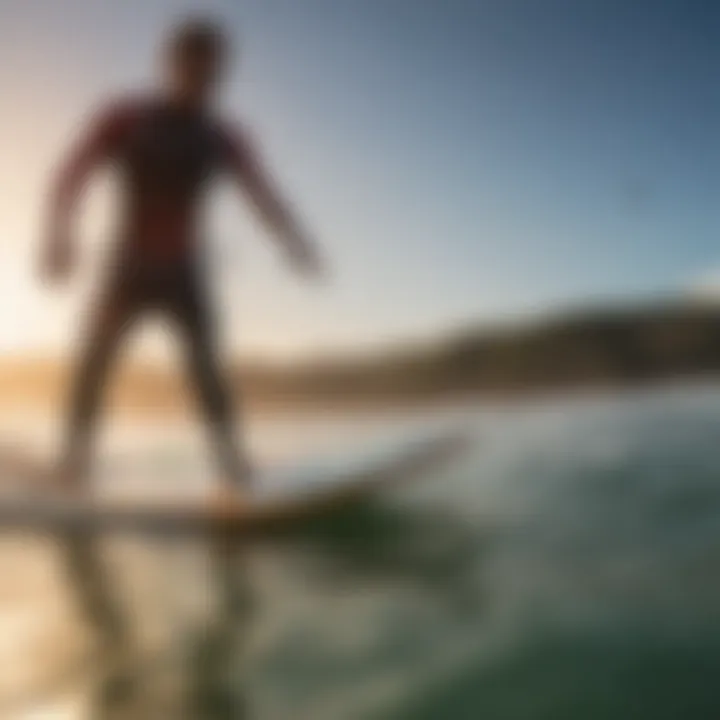Understanding Surfboard Dynamics in Kitesurfing


Intro
Kitesurfing combines the thrill of surfing with the power of a kite, producing an exhilarating experience that attracts enthusiasts from all walks of life. The fundamental aspect of kitesurfing is, without a doubt, the surfboard itself. Understanding the interplay between surfboards and kitesurfing can dramatically elevate a rider’s performance. This article takes a comprehensive look at these dynamics, focusing on aspects like surfboard variety, structures, and the different styles suited to various water conditions.
Whether you’re just starting out or have been riding the waves for years, recognizing how to choose the right board can make all the difference in your experience. It goes beyond personal preference; skill level, surfing conditions, and even maintenance play key roles in affecting how well a kitesurfer performs.
Before diving into the nitty-gritty details, it’s worth noting a few focal points:
- Performance characteristics of different boards
- The evolution of surfboards tailored for kitesurfing
- Technical aspects to prioritize when selecting a board
- Safety considerations that every kitesurfer should know
Each of these points weaves into the broader narrative of what makes the relationship between surfboards and kitesurfing so unique. Let’s kick things off by exploring the equipment necessary for an enriched kitesurfing experience.
Intro to Kitesurfing
Kitesurfing has become more than just a passing trend; it’s a vivid expression of freedom on water that combines elements of surfing, windsurfing, and paragliding. As more enthusiasts ride the waves, understanding the aerial dance offered by kitesurfing has grown increasingly essential. This article delves deep into the various elements of kitesurfing, particularly focusing on the crucial role surfboards play in enhancing the riding experience.
Historical Background
The roots of kitesurfing can be traced back to the 1970s when adventurous spirits experimented with kites tied to surfboards. Such attempts primarily aimed to harness the wind’s power on open waters. Yet, it wasn’t until the late 1990s that kitesurfing began to take form as a recognized sport, culminating in the establishment of various kitesurfing schools and competitions. The initial boards were rudimentary, designed more for function than finesse. As kitesurfing gained popularity, innovations in board design and technology followed suit, significantly impacting rider performance and safety. Many seasoned kitesurfers not only focused on quick tricks but also embraced the thrill of gliding through diverse conditions seamlessly.
Kitesurfing Equipment Overview
The kitesurfing experience is not just about the board; it involves a complex array of equipment designed to work in harmony with one another.
- Kite: The heart of this sport, kites come in various sizes and shapes which cater to different wind conditions and rider preferences.
- Harness: This indispensable gear connects the rider to the kite through a system of lines and is essential for maintaining control.
- Control Bar: This serves as the communication line between the rider and the kite, allowing adjustments in kite direction and power.
- Leash: A safety feature that attaches the rider to the board, usually used in case of a fall.
As much as these components play their roles, the surfboard remains a pivotal part. It influences not only how quickly a rider can get up on the water but also shapes the overall maneuvers and tricks they can achieve. Understanding nuances in surfboard types will give kitesurfers the tools they need to thrive in various conditions, ultimately elevating their skills.
Understanding the Surfboard's Role in Kitesurfing
When it comes to kitesurfing, the surfboard isn’t merely a piece of equipment; it’s the vessel that carries the rider over the water, making its design pivotal to the whole experience. Each board type brings its own set of characteristics that cater to specific riding styles and conditions. Understanding how these unique elements play a role in performance can help enthusiasts of all levels make informed choices that enhance their time on the water, preventing mishaps and maximizing fun.
Design and Structure
The design and structure of a kitesurfing surfboard can often feel like a blend of art and science. The board's shape influences how it performs in various conditions—think of it as the straw that sips up the experience of wind and wave. For instance, a directional surfboard, with its elongated shape and pointed nose, excels in carving through rough waters, carving up waves like a hot knife through butter. On the other hand, twin-tip boards provide versatility. They can be ridden in either direction, making them ideal for tricks and jumps.
Here’s a breakdown of some crucial design features:
- Rocker: Refers to the curve along the length of the board. More rocker can help in wave riding, allowing for smoother transitions.
- Width: A wider board provides more surface area, enhancing stability, making it easier for beginners to get the hang of things.
- Tail Shape: This affects the board’s ability to maintain speed and grip. A squared tail breaks through the water better, while a pintail aids in smoother turns.
Each aspect of design contributes to how a rider interacts with the water and wind, influencing maneuverability and performance.
Materials and Construction
Diving into the materials and construction of kitesurfing surfboards reveals a blend of innovation and durability—essential for ensuring performance and longevity. Most boards are constructed from a combination of foam cores and fiberglass, providing both lightweight characteristics and the strength needed to withstand the harsh marine environment.
- Foam Core: Typically, a lightweight foam is used that can float. Variants like EPS (Expanded Polystyrene) offer good buoyancy and is quite popular among various board designs.
- Fiberglass: This is layered over the foam, providing a protective shell, much like a shell on a turtle. It’s crucial for ensuring the board can endure the rigors of kitesurfing without cracking.
- Carbon Fiber: More advanced boards incorporate carbon fiber for its impressive strength-to-weight ratio; this allows for a snappier and more responsive ride but might come with a higher price tag.
When looking for a surfboard, understanding these materials can give riders insight into what will work best for their needs and conditions. A well-constructed board can often mean the difference between an exhilarating ride and a frustrating session.
"Understanding the materials and design of your surfboard not only affects performance but also plays a key role in rider safety."
Choosing the right surfboard isn’t a one-size-fits-all approach. It involves personal preference, understanding your intended riding style, and considering the conditions you’ll face on the water. When accurately matched, the right surfboard can significantly enhance the kitesurfing experience, empowering riders to explore this thrilling sport to its fullest.
Types of Surfboards for Kitesurfing
Understanding the various types of surfboards used in kitesurfing is crucial for optimizing performance and enhancing the experience on the water. With advancements in design and material, different boards cater to unique riding styles and environmental conditions. Choosing the correct type can greatly affect a rider's ability to maneuver, gain speed, and ultimately enjoy the sport.
Directional Surfboards
Directional surfboards are designed primarily for riders intending to cruise across the waves, offering a more traditional surfing experience. Unlike twin-tip boards, these surfboards are crafted to be ridden in one direction, resembling regular surfboards. This design optimizes performance for carving and riding swell. They generally feature:


- Narrower tails for improved maneuverability and stronger turns
- Longer noses that help to slice through water and maintain stability in choppy conditions
- Increased volume towards the tail, allowing for better paddle power and easier upwind riding
Benefits:
Directional surfboards are preferred for those who enjoy riding in waves and want a surf-like experience, providing a feel that resonates with traditional surfing. This type encourages riders to develop skills in carving and riding swells, honing their ability in different water conditions.
"Using a directional surfboard feels like reconnecting with the roots of surfing, immersing you deeper into the ocean’s rhythm."
Twin-Tip Boards
Twin-tip boards are distinctively versatile and are designed to be ridden in both directions. This allows kitesurfers to perform jumps and tricks with significant ease. Properties of twin-tip boards include:
- Symmetrical design that allows for quick transitions and a more forgiving feel
- Variety in sizes to cater for different riding styles, from beginners to advanced
- Flat rocker profiles that provide stability and speed on flat water, ideal for freestyle maneuvers
Considerations:
While twin-tip boards are perfect for tricks, they may not perform as well in waves compared to directional surfboards. However, their adaptability makes them an ideal choice for many riders, especially those who enjoy freestyle and urban environments.
Foil Boards
Foil boards represent a recent innovation in kitesurfing that adds a whole new dimension to how one interacts with the water. This type of board features an attached hydrofoil, which allows the board to lift above the surface when propelled by the kite. Key features include:
- Hydrofoil that significantly reduces drag, enabling smoother rides even in less favorable wind conditions
- Unique riding experience, offering sensations that differ from traditional surfing or kitesurfing styles, providing a floating feel as if the rider is gliding above the water
- Increased speed thanks to reduced friction against the water surface
Insights:
Foil boards are not for the faint of heart; they require practice and a solid understanding of kite control to master. Riders who seek a challenge and wish to explore the quieter waters often gravitate towards foil boards, expanding their kitesurfing experience beyond the limitations of conventional boards.
In essence, selecting the right surfboard for kitesurfing hinges on personal riding style, environmental conditions, and individual ambition on the water. Each type of board caters to a specific adventure, enhancing the thrill of kitesurfing and broadening the horizons of what riders can achieve.
Performance Characteristics of Kitesurfing Surfboards
When we talk about kitesurfing, the surfboard plays a pivotal role in defining the rider's experience. Performance characteristics not only influence how much fun one can have on the water but also impact safety and control. The dynamics of different surfboards can make or break your time spent kitesurfing, so understanding these elements is key for both enthusiasts and competitive riders.
Speed and Maneuverability
Speed and maneuverability are two closely related traits that define how a surfboard responds under varying situations. A board’s design and shape affect its hydrodynamics, which in turn can significantly impact how quickly it can reach its top speed. For instance, a narrower tail may help a board slice through the water more efficiently, allowing for sharper turns and quicker accelerations.
Benefits of Speed and Maneuverability:
- Enhanced Performance: Faster boards allow riders to gain momentum quickly, which is particularly useful in challenging winds.
- Responsive Handling: A highly maneuverable board can make quick adjustments, making it easier to traverse waves and avoid obstacles in the water.
- Tricks and Stunts: For those looking to perform aerial maneuvers or advanced tricks, boards designed with good speed and maneuverability are essential.
Nevertheless, finding the right balance between speed and control is crucial. A board that is too light might feel lively, but it can be hard to maintain control in stronger winds or choppy water. Therefore, kitesurfers often experiment with different boards until they find the perfect fit for their style and conditions.
Stability in Varied Conditions
In the world of kitesurfing, having a stable board can significantly enhance the riding experience, especially in unpredictable environments. Stability refers to how well a board maintains its equilibrium in different water conditions, whether it be choppy waves, gusty winds, or flat water.
Key Considerations for Stability:
- Board Width: A wider board generally offers increased stability, especially for beginners. It provides a larger surface area, which can help prevent wipeouts.
- Rockers and Channels: Lower rocker profiles and specific channel designs can help keep the board grounded in rough conditions.
- Weight Distribution: The balance of weight on the board plays an essential role in how stable the rider feels, especially during jumps and landings.
Overall, stability allows riders to focus on their skills rather than battling against the forces of nature. While every rider might have a different threshold for what they consider stable, new kitesurfers would benefit from boards that offer ample stability as they learn to navigate the complexities of the sport.
"A solid board can turn a learning curve into a staircase, enhancing confidence and ability in varying conditions."
In summary, understanding the performance characteristics of speed and stability within kitesurfing surfboards equips riders with the tools to select the right board that suits their needs, pushing the boundaries of their capabilities on the water.
Selecting the Right Surfboard
When it comes to kitesurfing, picking the right surfboard can make or break your experience on the water. It's not just about how it looks or what feels right in the shop; a well-chosen board directly impacts your performance. Whether you’re just starting or are seasoned pro, understanding how to align your personal needs with the board’s characteristics will optimize your time on the waves and enhance your riding pleasure.
Skill Level Considerations
The surfboard you choose has a profound connection to your skill level. For beginners, a wider, more stable board is often ideal. These boards provide extra buoyancy, making it easier to ride and balance. As you start mastering the basics like getting up on the board and staying upright, you might feel confident enough to flirt with a narrower design.
Intermediate riders often opt for boards that balance stability and performance. Here, versatility becomes key—selecting a board that can handle a variety of conditions will allow you to continue pushing your limits. Advanced kitesurfers generally seek specialized boards: those that take full advantage of their skills. There’s a world of performance-driven options out there, often crafted for specific tricks and maneuvers.


"Your surfboard is an extension of your riding style; choosing wisely can unlock new levels of enjoyment and mastery."
Typical Rider Weight and Riding Style
A kitesurfer’s weight isn’t just a number on the scale; it plays a critical role in board selection. Heavier riders typically need boards with more volume for buoyancy. Conversely, lighter riders can consider boards that are thinner. To put it plainly, if you weigh over 200 pounds, a board around 140 liters might serve you well, while an under 150-pound rider might thrive on a 120-liter board.
Riding style also factors in. Freestyle riders might lean towards more symmetric twin-tip boards that allow quick directional changes, while wave riders often prefer boards designed for carving and handling choppy waters. Catering to your specific style not only enhances your comfort but also boosts your performance, giving you the confidence to tackle more challenging tricks.
Environmental Conditions
The surf conditions where you plan to ride can change the game entirely. For flat waters, like lagoons or lakes, a flat and wide board would be suitable. On the other hand, if you're aiming to carve through waves, you might consider a directional surfboard that features a rocker to navigate through the swell smoothly. Riding in choppy conditions? A board with good volume will keep you nestled above the water’s surface, allowing for a steadier ride.
Furthermore, wind strength should also guide your selection. In higher winds, you may want a smaller board that won’t catch too much air, keeping you in control. Sizing your board to accommodate various environmental factors lets you adapt on the fly and ensures the enjoyment of every kitesurfing session.
In summary, selecting the right surfboard involves a careful consideration of your skill level, personal riding style, weight, and those often unpredictable conditions out on the water. Each element plays a vital role in your kitesurfing journey, and taking the time to consider these factors ahead can lead to a more fulfilling and skill-enhancing experience.
Techniques for Using Surfboards in Kitesurfing
Understanding the right techniques for using surfboards in kitesurfing is vital for enhancing your skill and overall enjoyment on the water. With the appropriate methods, a kitesurfer can improve their performance, developing both confidence and control. Whether you are just starting out or looking to refine your abilities, these techniques can make a difference in how effectively you navigate various conditions and challenges.
Effective kitesurfing techniques involve not only the physical act of riding but also the relationship between body position, kite control, and surfboard handling. Each element plays a role in maneuverability and stability. Riders who grasp these connections can reap several benefits, including improved speed, greater stability against the wind, and the ability to handle rougher waters with ease. In addition, mastering these techniques means less chance of accidents, making for a safer kitesurfing experience overall.
Basic Riding Techniques
Starting out with basic riding techniques is essential. Newbies to kitesurfing should familiarize themselves with essential skills that lay the foundation:
- Stance and Balance: Stand with feet shoulder-width apart on the board. This stance provides better balance, helps to distribute weight evenly, and keeps you centered.
- Edge Control: Learning to carve through the water using the board's edges is crucial. Shift your weight smoothly from heel to toe for turns, applying pressure to the edges as needed.
- Kite Control: Always maintain a direct line between the kite and your body. Keeping the kite steady in the power zone (about 45 degrees from the ground) provides optimal lift and thrust.
- Speed Regulation: Modulating your speed by adjusting the angle of the kite and shifting your body weight can help maintain control over tricky waters. When starting off, focus on keeping a constant speed.
These techniques form the core of kitesurfing and practicing them routinely builds a solid base for future progress.
Advanced Maneuvers
Once the basics are mastered, kitesurfers may wish to venture into advanced maneuvers that showcase skill and artistry on the water. These maneuvers can dazzle onlookers and elevate one's own experience during sessions:
- Jumping: This move requires a solid understanding of both kite and board mechanics. To jump, edge upwind and pull hard on the back hand, then transfer weight toward the front of the board, using the kite's lift to propel yourself.
- Turns and Carving: Advanced turns involve using speed and edge control to create sharp, dynamic movements. Rather than simply changing direction, try carving into the turn with your back foot, applying pressure to change your angle.
- Waves Riding: When riding waves, timing is essential. Align your board diagonally with the wave face and adjust your kite position to gain and maintain speed. This might require quick reflexes and adaptability to surging waves.
- Tricks and Freestyle: Practicing aerial tricks requires a solid grasp of both jumping and kite control. Combinations of spins, grabs, and flips add flair to your riding but should be approached with caution to prevent injuries.
"Mastery of techniques can transform kite surfing from a casual pastime into an exhilarating expression of skill and creativity."
Advancement through these maneuvers necessitates patience and practice. Safe progression is key, so focus on developing your techniques before attempting more complex moves. As the journey unfolds, you will find joy not only in riding but also in mastering the art behind it.
Safety Considerations When Kitesurfing
Safety is paramount in any adventure sport, particularly one as thrilling as kitesurfing. When you’re harnessing the power of the wind and gliding over the waves, it’s easy to get swept away in excitement. However, understanding and implementing safety measures ensures not only your protection but also that of others sharing the water space.
Personal Safety Gear
Equipping yourself with the right personal safety gear can't be emphasized enough. Consider the following essentials that every kitesurfer should have:
- Helmet: A quality helmet shields your head against unforeseen falls or collisions. Opt for one that provides adequate coverage while remaining lightweight for comfort.
- Impact Vest: This vest absorbs shock during crashes, providing both buoyancy and extra protection to your ribcage, which is particularly vulnerable when kiteboarding.
- Wetsuit: Protects against cold water which can sap your strength quickly. It also offers some degree of impact protection. Choose a suit that fits well, allowing for freedom of motion.
- Harness: A harness helps distribute the kite’s pull across your body, significantly reducing strain on your arms and back. There are seat and waist harnesses, but the choice boils down to rider comfort and moboitity.
- Safety Leash: Attach a safety leash between you and your kite to maintain control if you unexpectedly fall off the board.
These items not only add layers of protection but also help in sustaining your performance in the water.
Environmental Awareness
Every kitesurfer must cultivate an acute sense of environmental awareness. This awareness impacts both personal safety and the preservation of marine environments. Here are some aspects to consider:
- Weather Conditions: Always check the local weather reports. Sudden wind shifts or rapid changes in weather can pose significant risks, turning a fun day on the water into a hazardous situation.
- Tides and Currents: Understanding local tide patterns is critical. Be mindful of strong currents that could pull you away from shore or create difficulties in returning when conditions become agile.
- Wildlife: Many beaches can be home to marine life, from jellyfish to reef sharks. Knowing the local ecology helps in making informed decisions about where to kite surf.
- Rescue and Emergency Plans: Familiarize yourself with local rescue services and how to contact them if things go south. Make sure to have a reliable means of communication, like a waterproof mobile device.
"Safety first, because without it, the ride can quickly become a struggle."
By adhering to these safety measures and remaining conscious of your surroundings, kitesurfing can transform into not just a pursuit of thrill, but a deeply satisfying, worry-free adventure. It builds not only skills but knowledge that enriches every aspect of the sport.


Maintaining Your Kitesurfing Surfboard
Maintaining your kitesurfing surfboard is not merely an afterthought; it’s a fundamental part of enjoying the sport to its fullest. A well-kept board not only enhances performance but also extends its life significantly. From protecting your investment to ensuring safety while riding, the importance of upkeep can’t be overstated. Let’s break down what you need to consider to keep your surfboard in peak condition.
Storage and Protection
Proper storage is critical for the longevity of your surfboard. Here are some essential tips:
- Avoid Sun Exposure: UV radiation can damage the board's materials over time. Keep it covered or in a shaded area when not in use.
- Wall Racks or Vertical Storage: If possible, store your surfboard on a rack or vertically. This position helps maintain its shape and prevents any warping due to prolonged pressure on one side.
- Use a Board Bag: A fitted board bag protects against dings, scratches, and other potential hazards. Make sure your board is dry before putting it in the bag to avoid mold or mildew growth.
These considerations can save you a headache and some dough down the line. After all, nobody wants a cracked board when the waves are calling.
Repair Techniques
No matter how careful you are, wear and tear is part of the game. Familiarizing yourself with some basic repair techniques can help you keep your board in good shape, especially for the common issues experienced:
- Ding Repairs: A simple epoxy kit can fix small dings. Clean the area, mix the epoxy according to instructions, and smooth it out with a putty knife. Let it cure before hitting the waves.
- Leash Attachment Replacement: If your leash becomes loose or breaks, it’s essential to replace it promptly. Remove the old leash and ensure the new one is tightly secured.
- Fin Fixes: If you’re popping fins frequently, consider checking the screws and using a thread lock to ensure they stay secure.
"An ounce of prevention is worth a pound of cure."
By regularly inspecting your board and attending to minor repairs, you can prevent small issues from becoming major headaches. This way, you’ll be ready to ride the next wave without worrying about the stability or safety of your board.
The Future of Kitesurfing Surfboards
As kitesurfing continues to evolve, the surfboards designed specifically for this high-octane sport follow suit, adapting to the needs and preferences of riders who constantly strive for better performance. Understanding where the future is headed in the realm of kitesurfing surfboards is crucial for both seasoned veterans and newcomers alike. This future isn't just about chasing trends; it's about enhancing the overall experience, pushing boundaries, and ensuring that every time you hit the water, you can do so with confidence and flair.
The advancements in technology and design are essential elements shaping this future. Innovations can range from new shapes and sizes tailored to diverse conditions, to specialized materials that boost durability while reducing weight. These changes promise to not only improve performance on the waves but also significantly influence the way kitesurfers engage with their environment and their equipment.
Innovations in Design
Today’s kitesurfboards are witnessing a fusion of creativity and technology. Innovative design plays a huge role in enhancing performance. Modern surfboards might feature hydrofoil technology, allowing the board to lift above the water surface, reducing drag while increasing speed. This design shift caters to various styles of riding, be it freestyle tricks, wave riding, or simply cruising.
Riders can also look forward to adjustable fin systems that enable quick changes to accommodate different water conditions. This is crucial, as the dynamics of the ocean can change in the blink of an eye. With adjustable setups, riders can adapt their boards on-the-fly, ensuring optimal performance whether they’re facing choppy waters or perfectly glassy conditions.
"In the arena of kitesurfing, unyielding evolution is the name of the game—boards that can adapt shift the way riders experience the sport altogether."
Sustainability in Materials
In a world increasingly conscious of environmental impact, the kitesurfing industry is following suit. The future of kitesurfing surfboards will see a significant shift towards sustainable materials. Manufacturers are experimenting with bio-based resins, recycled foam cores, and other eco-friendly materials to produce boards that do not sacrifice performance for sustainability.
This eco-conscious movement is not just a trend; it’s a necessary change. As riders, being aware of how our choices affect the environment can ripple through communities, encouraging a more sustainable approach towards water sports.
Investing in gear that prioritizes eco-friendly practices is not only the future; it's a responsibility every kitesurfer carries. With advancements in material technology, riders can enjoy high-quality performance while promoting an ethos of environmental stewardship.
In summary, the future landscape of kitesurfing surfboards is one that resonates with innovation, adaptability, and sustainability. As the sport grows more popular, these advancements will provide kitesurfers with tools to push their limits while ensuring a legacy that respects our planet.
Epilogue
As we wrap up our exploration into the intricate dynamics of surfboards for kitesurfing, it becomes clear that understanding these elements is pivotal for any rider looking to enhance their experience on the water. Kitesurfing is not merely a sport; it's a fusion of adrenaline and art. The surfboard, as a key component of this practice, significantly influences performance and enjoyment.
In essence, educating oneself on the design, construction, and types of surfboards available can lead to more informed decisions. A well-chosen surfboard can impact speed, stability, and responsiveness, catering directly to the rider's style and the varying environmental conditions they may encounter. This aligns with the overarching theme of personal customization and understanding one's equipment that has become vital in modern kitesurfing.
Here are some salient points to take away from our discussion:
- Choice Matters: Finding a surfboard that resonates with your skill level and riding style can transform your kitesurfing experience.
- Performance: Different performance characteristics can affect how well you navigate various conditions, ensuring safety and enjoyment during your rides.
- Future Awareness: Embracing innovations and sustainability in surfboard design not only enriches individual practices but also contributes to the broader community's ethos of care for the environment.
"Selecting the right surfboard is like choosing a partner; they should complement your style and support your goals."
Recap of Key Insights
Throughout this article, we have delved into the multifaceted components of surfboards in the context of kitesurfing. From their historical evolution to modern innovations in materials and design, each aspect plays a significant role in rider experience. The thorough understanding of types of boards, their performance traits, and maintenance aspects not only enhances safety but fosters a deeper appreciation for the sport itself.
By synthesizing knowledge about the specific structures and features that resonate with personal kitesurfing goals, enthusiasts can make well-rounded choices, optimizing their time on the water.
Encouraging Continued Exploration
The realm of kitesurfing is vast and ever-evolving, with new technologies and methodologies emerging regularly. Engaging with communities on platforms like Reddit or following relevant discussions on Facebook keeps riders informed and connected. It’s important for both novices and veterans to stay curious and keep exploring different aspects of the sport.
Additionally, consider attending local kitesurfing workshops and demos, where firsthand experience with various boards can illuminate your understanding further. Each moment on the water can be a lesson; embrace it, adapt, and keep pushing the boundaries of your skills. Kitesurfing isn't just a sport; it's a journey. Whether you're catching waves or mastering jumps, the adventure continues with each ride.







